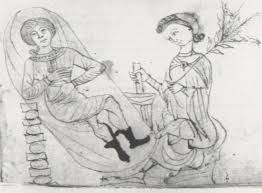History of abortion in the Greco-Roman world

In his Theaetetus, Plato mentions a midwife's ability to induce abortion in the early stages of pregnancy
The ancient Greeks relied upon the herb silphium as an abortifacient and contraceptive. Pliny the Elder (23–79 CE) cited the refined oil of common rue as a potent abortifacient.
Soranus, a 2nd-century Greek physician, prescribed diuretics, emmenagogues, enemas, fasting, and bloodletting for abortion
Tertullian, a 2nd- and 3rd-century Christian theologian, described surgical implements which were used in a procedure similar to the modern dilation and evacuation
Aulus Cornelius Celsus, a 1st-century Roman encyclopedist, offered an extremely detailed account of a procedure to extract an already-dead fetus in his only surviving work, De Medicina.
The History of Christianity theology and Abortion

The Bible's Exodus 21:22–24 describes accidentally hitting a pregnant women's stomach causing a premature birth
The accident is described as not resulting in further injury as a non-capital offense and a "non-serious injury", unless it results in the crime of murder
Commentators such as Bruce Waltke have presented this as evidence that "God does not regard the fetus as a soul
Numbers 5:11-31 describes the test of the unfaithful wife were a woman has to drink a special water which will cause her to miscarry if she is unfaithful
Currently, the Roman Catholic, Eastern Orthodox, Evangelical Protestant and some mainline Protestant churches oppose abortion while protestant churches favor permitting abortion
The history of Judaism theology and abortion

In Judaism, views on abortion draw primarily upon the legal and ethical teachings of the Hebrew Bible, the Talmud
The chief biblical source referring to abortion is Exodus 21:22–25 concerning the man who inadvertently strikes a pregnant woman, causing her to either give birth prematurely or to miscarry.
The Mishnah reference in Oholot 7, 6 says a fetus can be killed to save the life of the woman if it is life-threatening
In Talmudic law, an embryo is not deemed a fully viable person (bar kayyama), but rather a being of "doubtful viability" (Niddah 44b) hence no mourning rites an unborn child
In the Talmud: in Yevamot 69, 2 the fetus in the first forty days of pregnancy is likened to water, in Nida 8, 2 the fetus is recognized from the second trimester


